air condition AUDI A5 COUPE 2011 User Guide
[x] Cancel search | Manufacturer: AUDI, Model Year: 2011, Model line: A5 COUPE, Model: AUDI A5 COUPE 2011Pages: 362, PDF Size: 84.88 MB
Page 111 of 362

_______________________________________________ W_ a _r_m _ a_ n_d _ c_o _l_ d _ __.ffl'I
The following functions can be selected :
• Auto recirculat.
~ page 109
• Synchronization~
page 109 •
Applies to vehicles: with D eluxe automatic climate con trol plus
Automatic recirculation
An air quality sensor detects increased concentrations of
pollutants in the outside air and automatically switches to recirculation mode.
We recommend that you always keep automatic recirculation ON to
prevent polluted outside air from entering the vehicle interior .
If the
air quality sensor located in the climate control system detects
polluted outside air, the sensor decides whether the air pollution can
be reduced by the factory-installed pollutant filter or whether it is
necessary to switch to recirculation. With heavy concentrations of
pollutants, the climate control system is switched automatically to
recirculation mode and the supply of outside air is blocked . As soon
as the concentration of pollutants in the outside air drops, fresh air is
supplied to the vehicle interior again.
I n the event that the windows fog up during automatic recirculation ,
press the
l<:wl button immediately.
Under certain operating conditions, automatic recirculation is
switched off automatically. When outside temperatures are below
about
50 °F ( +10 °C), automatic recirculation is limited to
30 seconds. When outside temperatures are below about 30 °F (-
1 °C),
automatic recirculation is limited to 15 seconds.•
Con tro ls a nd e quip
m en t Vehicle
OP-eration
Applies to vehicles: with Deluxe automatic climate control plus
Synchronization
One climate control setting for all seats .
After Synchronization is set to On, all of the subsequent climate
control settings (except for seat heating*) for the driver are trans
ferred to the front passenger .
Synchronization is canceled when settings are adjusted on the front
passenger's side .•
Seat heating
App lies to v ehicl es: w ith front se at heati ng
Front seat heating~
The seat cushion and the seatback of the front seats can
be heated electrically.
- Press the (g button.
Fig. 105 Seat heating
button and regulator
-Rotate the regulator to the desired setting.
In position 0, seat heating is turned off. The control range is from 1
to 6 . .,,
Vehicle care Do-it-yourselt service iTechnical data
Page 161 of 362
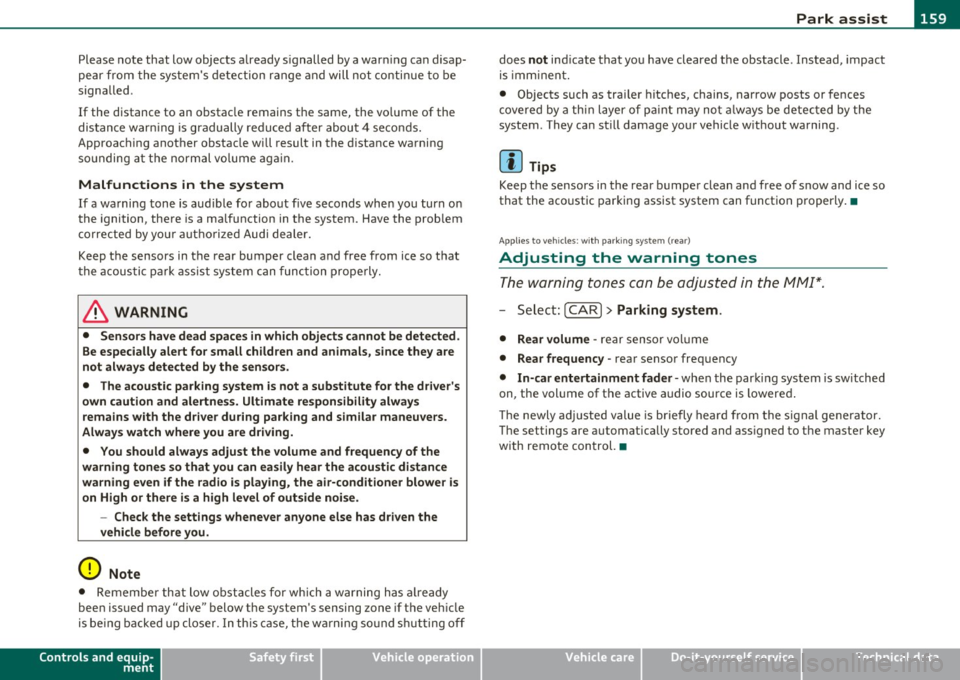
___________________________________________________ P_a _r _k _ a_s _s_ i_s _t __ _
Please note that low objects a lready s ignalled by a war ning can disap
pe ar from the sys te m 's d etection r ange and will not co nti nue to be
signa lled .
If the distance to an obstacle remains t he same, the vo lume of the
dis tan ce warn ing is gradu ally redu ced af ter abou t 4 seco nds.
Approaching another obstacle will result in the distance warning
s ou nding a t th e normal vo lume aga in.
Malfunctions in the system
If a wa rning tone is aud ible fo r about five seconds when you turn o n
the ignition , there is a ma lfunction in the system. Have the prob lem
c o rrected by yo ur auth orized Aud i de aler.
Keep the sensors in the rear bumper clean and free from ice so t hat
t he acous tic par k ass ist system can func tion prope rly.
& WARNING
• Sens ors have dead space s in whi ch objects cannot be dete cted.
Be especi ally alert for small children and animals , since they are
not alway s detected by the sen sors.
• The acou stic parking system is not a substitute for the dr iver 's
own caution and alertne ss. Ultimate respon sibility alway s
remains w ith the driver during parking and similar maneuvers.
Alway s w atch wh ere you are driving .
• You should always adjust the volume and frequency of the
warning tone s so that you can e asily hear the acoustic di stan ce
wa rning e ven if the radio is pl aying, the air -conditioner blowe r is
on High or there i s a high level of out side noi se .
- Check the setting s whenever anyone else has driven the
vehicle before you.
0 Note
• Remember that low obst acles fo r which a warning has a lready
been issued may "d ive" below the system 's sensing zone if the ve hicle
is be ing b acked up closer . In th is case, the wa rni ng so und shutting off
Controls and equip
ment Safety first
does not ind
icate that you have cleared the obstacle . Instead, impact
is imm inen t.
• Objects such as trai ler hitches, chains, narrow posts or fences
c ove red by a th in layer of paint m ay no t always be detec ted by the
system . They can st ill damage your vehicle w ithout warning .
lI] Tips
Keep the sensors in the rear b umper clean and free of snow and ice so
that the aco ustic parki ng assist system can function proper ly .•
App lies to ve hicles : w it h pa rkin g system (re ar)
Adjusting the warning tones
The warning tones can be adjusted in the MMI*.
-Select : [CAR]> Parking sy stem .
• Rear volume · rear sensor vol ume
• Rear frequ ency -rear sensor frequency
• In-car entertainment fad er-when the park ing system is switched
on , the vol ume of the active audio source is lowered .
Th e newly adj usted value is br iefly heard from the signa l gene rator.
The settings are automatically stored and ass igned to the master key
with remote control. •
Vehicle care Technical data
Page 167 of 362
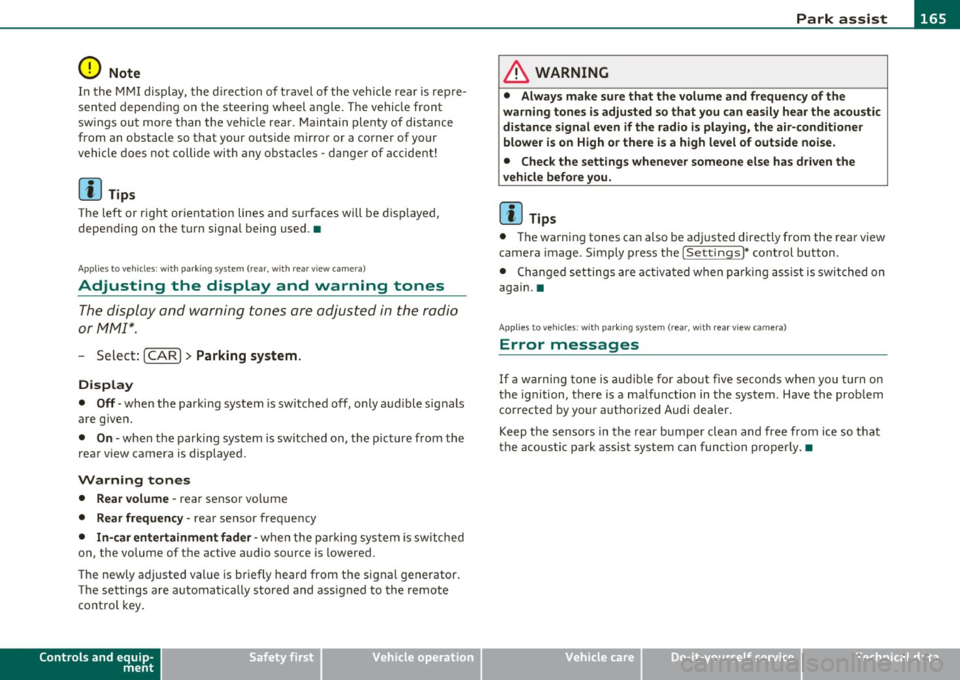
Park assist IIJII _________________________________ _____;.....:;_;_.:..:,____;;_ ____ _
0 Note
In the MMI display, the d irect ion of t ravel of the vehicle rear is rep re
sented depend ing on the steering wheel angle. The vehicle front
swi ngs ou t mo re t han t he ve hicle re ar. M ain tain ple nty of dist ance
from an obstacle so t hat your outs ide mirror or a corner of your
vehicle d oes no t collide with any o bstacles - dange r of accide nt!
[ i ) Tips
Th e left or right or ientat ion lines and s urfaces will be displ aye d,
depending on the tu rn signal being used. •
App lies to veh icles : with park ing syst em (rear, wit h rea r view cam era)
Adjusting the display and warning tones
The display and warning tones are adjusted in the radio
or fv1fv1 I*.
-Select : [CAR]> Parking system.
Display
• Off -
when the parking system is switched off, only aud ible sig nals
are given.
• On -when the pa rking system is switc hed on, the pic ture from the
rea r view camera is displayed.
Warning tones
• Rear volume -rear sensor vo lume
• Rear frequency -rear sensor frequency
• In-car entertainment fader -when the par kin g sys tem i s sw itched
on, the volume of the active audio source is lowered.
T he newly a djusted value is br iefly hear d from the signal generator .
T he settings are automatica lly stored and assigned to the remote
cont rol key.
Controls and equip
ment Safety first
& WARNING
•
Always make sure that the volume and frequency of the
warning tones i s adju sted so that you can easily hear the acou stic
distance signal even if the radio is playing , the air-conditioner
blower is on High or there is a high level of outside noise.
• Check the settings whenever someone else has driven the
vehicle before you.
[I] Tips
• Th e warning tones can also be ad justed directly from the rea r view
camera image . Simply p ress the
[Settings I* cont rol b utton .
• C han ged settings are a ctivat ed w hen parking assist is switched on
again .•
A pplies to v ehicl es: w ith park ing syst em (r e a r, wi th re ar view cam era)
Error messages
If a warni ng tone is aud ible fo r about five se conds when yo u turn on
the ignition, the re is a ma lfunction in t he system. Have the prob lem
co rrected by yo ur a utho rized Audi dea ler .
K eep the se nsors in the rear b umper clean and free from i ce s o th at
the acoustic pa rk assist system can function p roper ly .•
Vehicle care Technical data
Page 173 of 362
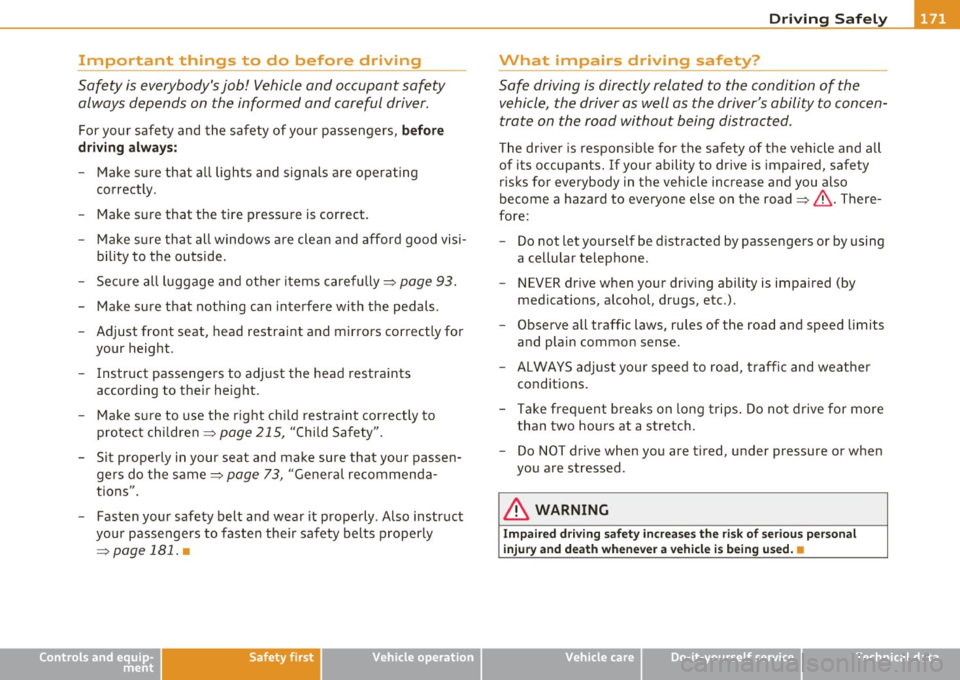
Driving Safely ---------------------"~'---
Important things to do before driving
Safety is everybody's job! Vehicle and occupant safety
always depends on the informed and careful driver.
For your safety and the safety of your passengers, before
driving always:
- Make sure that all lights and signals are operating
correctly.
- Make sure that the tire pressure is correct.
- Make sure that all windows are clean and afford good visi-
bility to the outside.
- Secure all luggage and other items carefully::::>
page 93.
-Make sure that nothing can interfere with the pedals.
- Adjust front seat, head restraint and mirrors correctly for your height .
- Instruct passengers to adjust the head restraints according to their height.
- Make sure to use the right child restraint correctly to
protect children ::::,
page 215, "Child Safety".
- Sit properly in your seat and make sure that your passen gers do the same::::,
page 73, "General recommenda
tions".
- Fasten your safety belt and wear it properly. Also instruct
your passengers to fasten their safety belts properly
=:> page 181. •
Controls and equip
ment Safety first Vehicle operation
What impairs driving safety?
Safe driving is directly related to the condition of the
vehicle, the driver as well as the driver's ability to concen
trate on the road without being distracted .
The driver is responsible for the safety of the vehicle and all
of its occupants. If your ability to drive is impaired, safety
risks for everybody in the vehicle increase and you also
become a hazard to everyone else on the road::::,,& . There
fore:
Do not let yourself be distracted by passengers or by using
a cellular telephone.
NEVER drive when your driving ability is impaired (by
medications, alcohol, drugs, etc.).
- Observe all traffic laws, rules of the road and speed limits
and plain common sense .
- ALWAYS adjust your speed to road, traffic and weather
conditions.
- Take frequent breaks on long trips. Do not drive for more than two hours at a stretch.
- Do NOT drive when you are tired, under pressure or when
you are stressed .
& WARNING
Impaired driving safety increases the risk of serious personal
injury and death whenever a vehicle is being used.•
Vehicle care Do-it-yourself service Technical data
Page 194 of 362
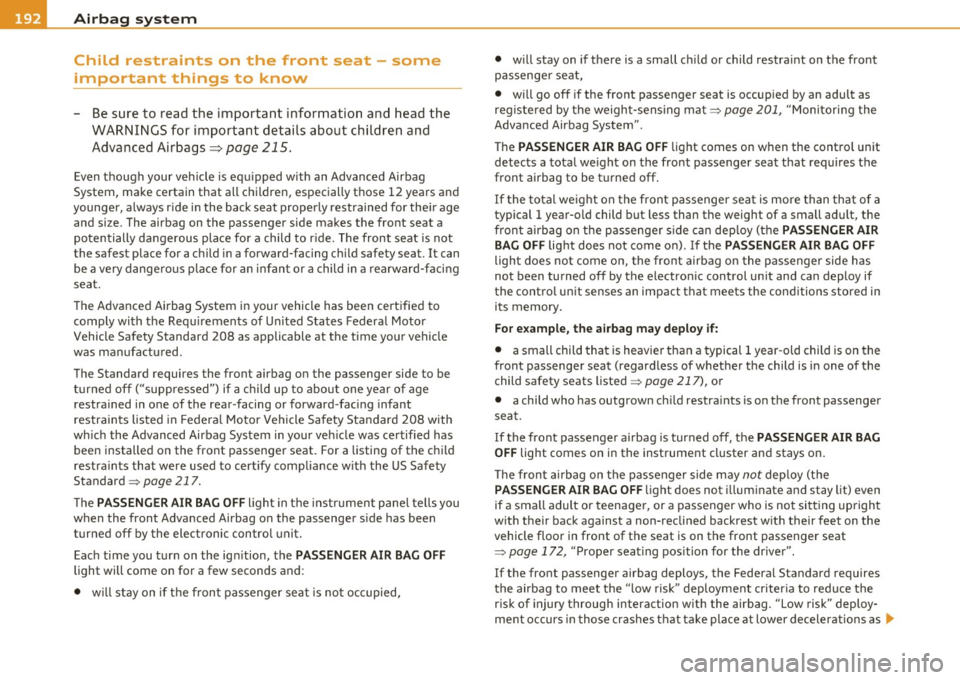
........ _A_ i_rb _ a_,g,:;._ s_, y'- s_ t_e _m ________________________________________________ _
Child restraints on the front seat - some
important things to know
- Be sure to read the important information and head the WARNINGS for important detai ls about children and
Advanced Airbags =:>
page 215.
Even though your veh icle is eq uipped with an Advanced Airbag
System, make certain that all ch ildren, especially those 12 years and
younger, a lways r ide in the back seat properly rest rained for the ir age
and size . The airbag on the passenger side makes the front seat a
poten tially dangerous place fo r a child to r ide. The front seat is not
the safest place for a child in a forward-facing c hild safety seat. It can
be a ve ry dange rous place fo r an infant or a child in a rearward-fac ing
seat.
T he Advanced Airbag System in your vehicle has been cert ified to
comply with the Req uirements of United States Federa l Moto r
Vehicle Safety Standard 208 as applicable at the time your vehicle
was ma nufactu red .
The Standard requires the front airbag on the passenger side to be tu rned off ("supp ressed") if a c hild up to abo ut one year o f age
restra ined in one of the rear -facing or forward -fac ing infant
restrain ts listed in Federa l Moto r Vehicle Safety Sta ndard 208 with
w hich the Advanced Airbag System in your veh icle was certified has
been installed on the front passenger seat. For a listing of the chi ld
restra ints that were used to cert ify complia nce w ith the US Safety
Standard =>
page 217.
The PASSENGER AIR BAG OFF ligh t in t he inst rumen t panel tells you
when the front Advanced Airbag on the passenger s ide has been
tu rn ed off by the electronic con tro l u nit.
Eac h time you turn on the ign ition, the
PASSENGER AIR BAG OFF
light will come on for a few seconds and:
• will stay on if th e fron t passenger seat is no t occupied, •
will stay on if there is a small ch ild or child restra int on the front
p assenge r seat,
• will go off if the front passenger seat is occup ied by an adult as
reg iste red by the weight-sens ing mat =:>
page 201, "Monitori ng the
Adva nced Airbag System" .
Th e
PASSENGER AIR BAG OFF light comes on when the control unit
detects a tota l we ight on the front passenger seat t hat req uires the
front airbag to be t urned off.
If the tota l we ight on the front passenger sea t is more than th at of a
typical 1 year-old child but less than the weight of a small adu lt, the
front airbag on t he p assenger s ide c an dep loy (the
PASSENGER AIR
BAG OFF
li g ht does not come on) . If the PASSENGER AIR BAG OFF
light does not come on, the front airbag on the passenger side has
not been tu rned off by the e lectron ic control u nit and can deploy if
the contro l unit senses an impact that meets the conditions stored in
its memory.
For e xample , the a irbag may deploy if:
• a small chi ld that is heavier than a typical 1 year -old child is on the
front passenge r seat (regardless of whether the child is in one of the
child safety seats listed =>
page 217), or
• a chi ld who has outgrown ch ild restra ints is on the front passenger
seat.
If the front passenger a irbag is turned off, the
PASSENGER AIR BAG
OFF
light comes on in the instrument cluster an d stays o n.
Th e front airbag on the passenger side may
not dep loy (t he
PASSENGER AIR BAG OFF light does not illum inate and stay lit) even
if a small adult or teenage r, or a passenger who is no t si tting upright
w ith the ir back against a non-recli ned backrest w it h their feet on the
vehicle floor in front of the seat is on the front passenger seat
=:>
page 172, " P rope r seat ing pos ition for the dr ive r" .
If the front passenger airbag deploys, the Federal Standard requ ires
th e airb ag to meet the "low risk" deployment criteria to red uce the
r is k of injury through interaction with the airbag. "Low risk" deploy
ment occurs in those crashes t hat ta ke place a t lower decelerations as .,.
Page 197 of 362
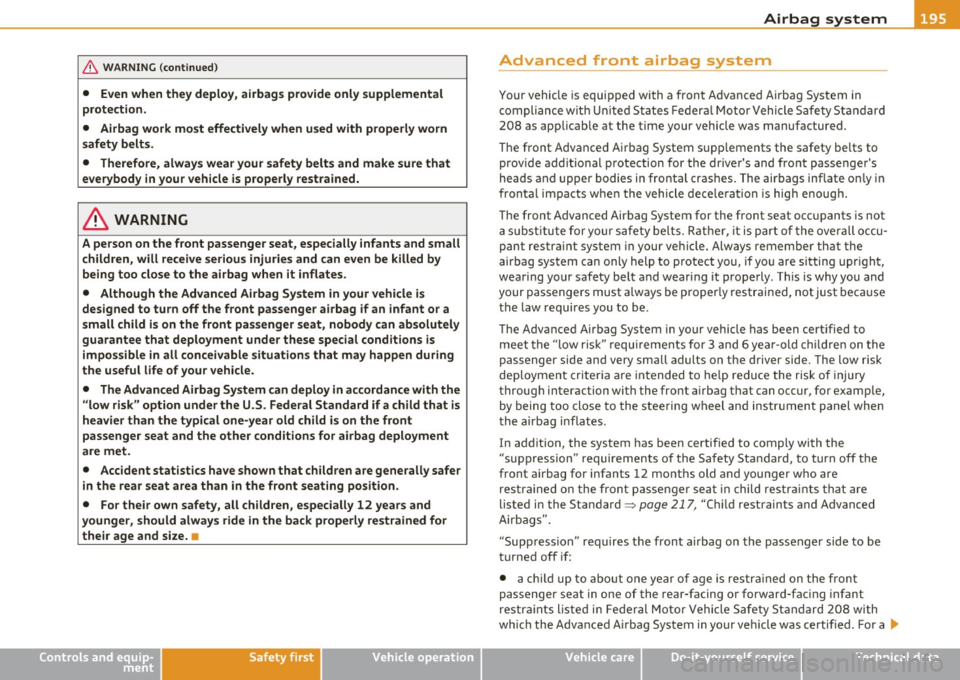
_______________________________________________ A_ ir_ b_ a_,,,g ~ s,,._y _s _t_ e _ m ___ _
& WARNING (co ntinued )
• Even when they deploy, airbags provide only supplemental
prot ection .
• Airbag work most effectively when u sed with p roperly worn
safety belts .
• Therefore, always wear your safety belts and make sure that
everybody in your veh icle is properly restrained.
& WARNING
A person on the front passenger seat , especially infants and small
c hildren, will re ceive serious injuries and can even be killed by
being too close to the airbag when it inflates.
• Although the Advanced Airbag System in your v ehicle is
designed to turn off the front passenger ai rbag if an infant or a
s mall child i s on the front passenger seat, nobody can ab solutely
guar antee that deployment under these special conditions is
impossible in all conceivable situations that may happen during
the useful life of your veh icle.
• The Advanced Airbag System can deploy in accordance with the
" low risk" option unde r the U .S . Federal Standard if a child that is
heavier than the typical one-year old child is on the front
passenge r seat and the other conditions for airbag deployment
are met.
• Accident statistics have shown that children are generally safer
in the rear seat area than in the front seating position.
• For their own safety, all children, especially 12 years and
younger, should alway s rid e in the back properly re strained for
their age and size. •
Controls and equip ment Safety first Vehicle operation
Advanced front airbag system
Your vehicle
is equipped with a front Advanced Airbag System in
co mpliance wit h United St ates Feder al Motor Vehicle S afety St andar d
208 as applicab le at the time your vehicle was manufactured .
Th e front A dvanced A irbag System supp lements the safety be lts to
prov ide addit ional protection for the dr iver's and front passenge r's
heads and upper bodies in frontal crashes. The airbags inflate o nly in
frontal i mpacts w he n t he vehicle de ce le ra ti on is high enoug h.
The front Advanced Airbag System for the front seat occupants is not
a s ubstitu te for your s afety be lts. R at he r, it is p art o f the ove rall occu
pant restrai nt system in your ve hicle. Always remembe r that the
air bag sys tem can on ly help to protect you, if yo u are s itting upr ight,
wearing your safety be lt and wear ing it properly . This is why you and
your passengers must always be p roper ly restra ined, not just beca use
the law requires you to be .
The Advanced Airbag System in your vehicle has been cert ified to
meet the " low r is k " requi remen ts for 3 and 6 ye ar-old childr en on the
passenger side and very sma ll adults on the driver side. The low risk
deployme nt criter ia a re in tended to he lp red uce the risk o f inju ry
throug h interaction with the fro nt a irbag tha t can occur, for examp le ,
by being too close to the stee ring wheel an d instr ument panel whe n
t he a irba g inflates.
In addit ion, the system has bee n certified to comply with the
"supp ression " requireme nts of the Safety Sta ndard, to turn off th e
front airbag for infants 12 mo nths old and you nger who are
re strai ned o n the fron t pa ssenge r sea t in child res tra ints that are
listed in the Standard=>
page 217, "Chil d restraints and Advanced
Air bag s".
" Supp ression" requ ires the front a irbag on the passenger side to be
turne d off if:
• a child up to a bout one year o f age is re stra ined on the fron t
passenger seat in one of the rear-facing or forward-fac ing infant
restr aints liste d in F ed er al M oto r Ve hicl e Sa fety S tandard 208 with
w hich the Advanced A irbag System in yo ur ve hicle was certified. For a ...
Vehicle care Do-it-yourself service Technical data
Page 198 of 362
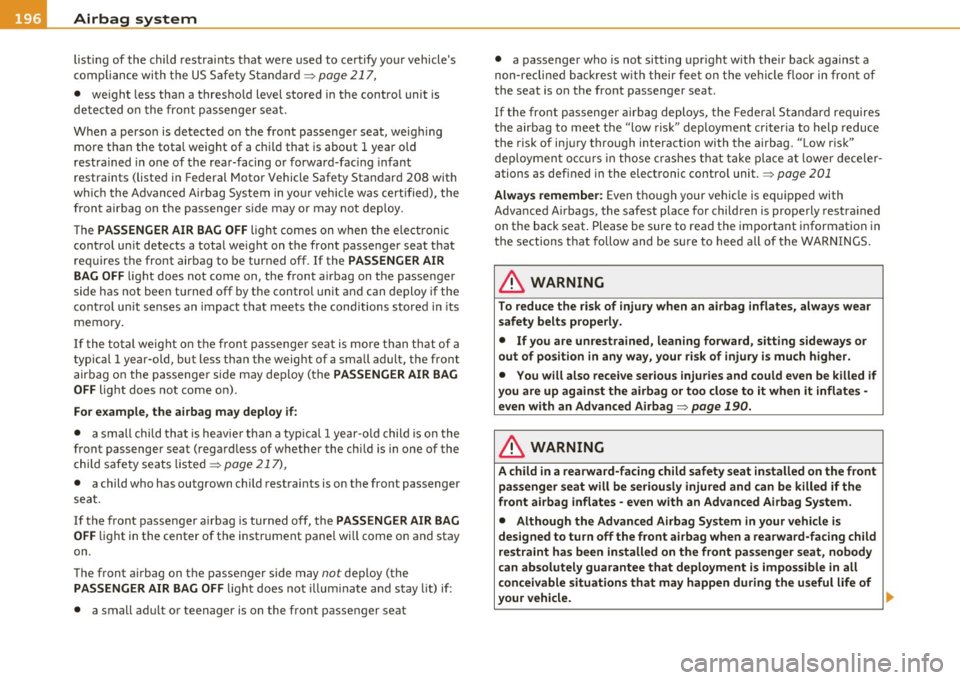
........ _A_ i_rb _ a_,g,:;._ s_, y'- s_ t_e _m ________________________________________________ _
listing of the child res traints that were used to certify your vehicle's
compliance with the US Safety Standard
~ page 217,
• weight less than a thresho ld level stored in the contro l unit is
detected on the front passenger seat.
When a perso n is detected on the front passenger seat, weigh ing
more than the tota l weight of a child that is about 1 year old
restra ined in one of the rear-facing or forward-fac ing infant
restraints (listed in Federal Motor Vehicle Safety Standard
208 with
w hich the Advanced Ai rbag System in you r ve hicle was cert ified), the
front airbag on the passenger s ide may or may not dep loy .
T he
PASSENGER AIR BAG OFF ligh t comes on when the elect ronic
cont rol un it detects a total weight on the front passenger seat that
requires the front airbag to be turned off. If the
PAS SENGER AIR
BAG OFF
light does not come on, the front a irbag on the passenger
side has not been turned off by the control unit and can deploy if the
cont rol unit senses an impact that meets the conditions stored in its
memory .
If the total weight o n the fron t passenge r seat is more than that of a
typical
1 year-old, but less than the weight of a small adult, the fron t
airbag on the passenge r side may deploy (the
PASSENGER AIR BAG
OFF
light does not come on).
F o r example , the airbag may deploy if:
• a small chi ld tha t is heavie r th an a typ ica l 1 year-o ld child is on the
front passenger seat (regard less of whether the chi ld is in one of the
child safety seats listed
~ page 217),
• a child who has outgrown child restraints is on the front passenge r
seat.
If the front passenger a irbag is turned off, the
PASSENG ER AIR BAG
OFF
light in the center of the instrument panel wi ll come on and stay
on .
The front a irbag on the passenger side may
not deploy (the
PASSENGER AIR BAG OFF l ight does no t ill um inate and s tay lit) if:
• a small adu lt or teenager is on the front passenger seat •
a passenger who is not sitting upr ight w it h their back against a
non -recli ned b ackrest w it h t heir fee t on the vehi cle floor in front of
the seat is on the front passe nger seat.
If the front passenger airbag deploys, the Federal Standard requires
the airbag to meet t he "low risk" deployment criter ia to help reduce
the risk of inj ury through interaction with the a irbag. "Low r isk"
dep loymen t oc cur s in those crashes t hat take pl ace at lower de celer
ations as defined in the electronic contro l unit.~
page 201
Alway s remember: Even though your ve hicle is eq uipped with
Adva nced A irbags, the safest place for children is properly restra ined
on the back seat. Please be sure to read the important information in
the sections that follow and be su re to heed all of the WAR NINGS.
& WARNING
To reduc e the risk of injur y when an airbag inflates , always wear
s a fety belt s properly.
• If you are un restrained, leaning forward, s itting sideways or
out of po sit ion in any way , your risk of injury is much higher .
• You will also receive seriou s injuries and could e ven be killed if
you are up against the airbag or too close to it when it inflate s -
even with an Advanced Airbag~
page 190.
& WARNING
A child in a rearward-facing ch ild safety seat installed on the front
pa ssenger seat will be seriou sly injured and can be killed if the
front airbag inflates - even with an Ad vanced Airbag S ystem .
• Although the Advanced Airbag System in your vehicle is
designed to turn off the front airbag when a rearward-facing child
restraint has been installed on the front p assenger seat , nobody
can absolutely gua rantee th at deployment is imposs ible in all
con ceivabl e situation s that may happen during the u seful life of
your vehicle . .,_
Page 203 of 362

_________________________________________________ A_ ir_ b_ a_,,g :;..__ s-=y '"- s_ t_ e_ m __ _
& WARNING (co ntinued )
airbag during braking or in a sudden maneuver. Objects near the
airbags can b ecome projectiles and cause injury , particularly when
the seat is reclined.
& WARNING
The fine dust created when airbags deploy can c ause breathing
problems
for people with a history of asthma or other breathing
conditions.
• To
reduce the risk of breathing probl ems, those with asthma or
other respiratory conditions should get fresh air right away by
getting out of the vehicle or opening windows or doors.
• If you are in a colli sion in which airbags deploy, wash your
hands and face with
mild soap and water before eating .
• Be careful
not to get the dust into your eyes, or into any cuts or
scratches.
• If the residue should get into your eyes, flush them with
water. •
Monitoring the Advanced Airbag
System
Airbag monitoring indicator Light~~
Two sep ara te i ndic a to rs mo nit o r the func tio n of the
A dvan ced Ai rb ag Sy stem: th e airbag mo nito ring i ndic ator
lig ht and th e
PASSENGER AIR BAG OFF light.
The A dvanced A irbag System ( includ ing the elect ronic contro l unit,
senso r circu it s and system wir ing) is mon it or ed co ntinuous ly to make
sure that it is function ing p roperly whenever the ignition is on. Eac h
tim e you turn on the igni tion, the airba g mo nitoring indicat or ligh t
t:.
will come o n for a few seconds (se lf diagnostics) .
Controls and equip
ment Safety first Vehicle operation
The system must be inspected when the indicator
light ~:
• does not come o n when the ignit io n i s switched on,
• does not go o ut a few se conds a fter you h ave switche d on t he ig ni
tion, or
• co mes on whil e dr iving.
If a n airbag system malfunction is detected, the ind icator light will
fi rst start flashing to catc h the dr iver 's attention and t hen stay on
cont inuo usly to s erve as a constan t rem inder to have the system
inspected immediately .
If a ma lf u ncti on oc curs that tur ns th e fron t air bag on the passe nger
side off, the
PASSENGER AIR BAG OFF light will come on and stay on
w henever the ignition is on.
& WARNING
An airbag system that is not functioning properly cannot provide
supplemental p rotect ion in a frontal crash .
• If the airbag indicator light comes on, it means that there may
be something wrong with the Advanced Airbag System. It is
possible that the airbag will inflate when it is not supposed to, or
will not inflate when it should .
• Have the airbag system inspected immediately by your autho
rized Audi dealer. •
Vehicle care Do-it-yourself service Technical data
Page 217 of 362
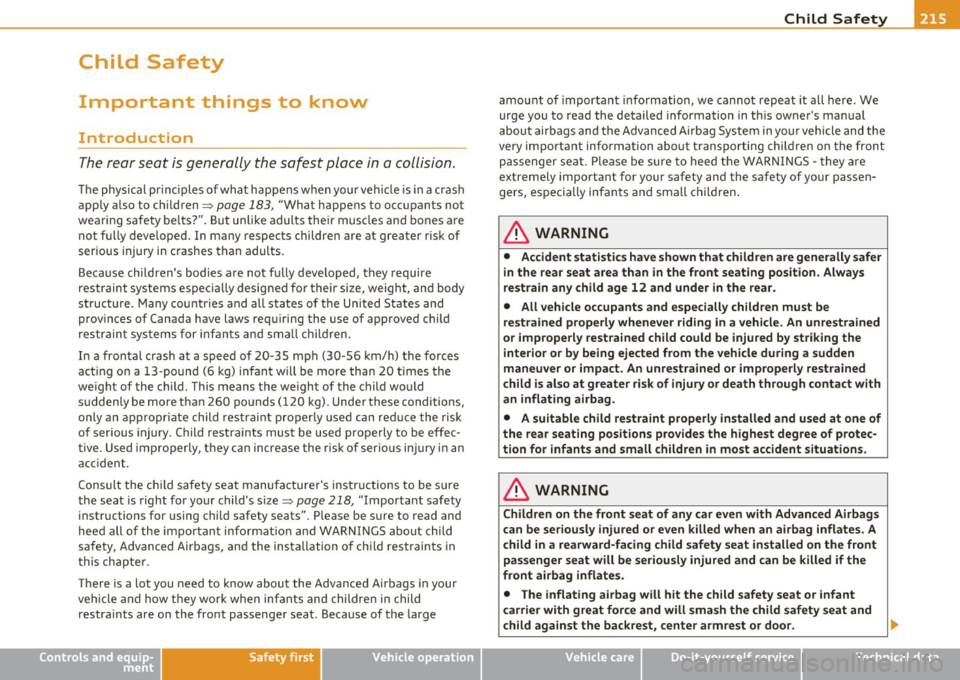
Child Safety Ill
-------------------"'---
Child Safety
Important things to know
Introduction
The rear seat is generally the safest place in a collision.
The physical pr in ci ples o f wha t happens w hen yo ur vehicl e is in a crash
app ly a lso to children=>
page 183, "What happens to occupants not
wearing safety be lts?". But unlike adults their mus cles an d bones a re
not fully deve loped. I n many respects children are at greater risk of
serious injury in crashes than adults .
Because children 's bodies a re not f ully deve loped, they require
restraint systems especially designed fo r their size, weight, and body
st ruct ure. Many cou ntries and a ll states of t he Unite d States and
prov inces of Canada have laws req uiring the use of approved ch ild
restrain t sys tems for infan ts an d sm all ch ild ren .
I n a fronta l crash at a speed of 20-35 mph (30-56 km/h) the forces
act ing o n a 13- pound (6 kg) infant w ill be more than 20 times the
we ight of the ch ild . This means the we ight of the child wo uld
suddenly be more than 260 po unds (120 kg). Under these conditions,
only a n app ropr iat e child restra int proper ly used can red uce the risk
o f serious injury. Child restrai nts must be used properly to be e ffec
t ive. Used i mpro perly, t hey can increase the risk of serio us injury in an
acc ident.
C onsult the ch ild safety seat manufacturer's i nstr uctions to be s ure
t he seat is right for your child's size
=> page 218, "Importa nt safety
instructions for using ch ild safety seats" . P lease be sure to read and
heed all of the impo rtant informat io n and WARNINGS about child
safety, Advanced Airbags, and the insta llation of ch ild rest raints in
t his chapte r.
There is a lot you need to know about the Advanced Airbags in your
vehicle and how t hey wo rk when inf ants and childre n in child
restra ints are on the front passenger seat. Beca use of t he large
Controls and equip
ment Safety first Vehicle operation
amou
nt of importa nt info rmation, we cannot repeat i t all he re. We
urge you to read the detailed information in th is owne r's man ua l
abou t airbags and t he Advanced A irbag System in your vehicle and the
very important information abo ut transporting c hildren on the front
p assenger se at. P lea se be sure to heed the WARNIN GS - they a re
extremely important for your safety and the safety of your passe n
gers, especially infan ts and small ch il dre n.
& WARNING
• Accid ent statisti cs have shown that children are generally safer
in the rear seat area than in the front seating position. Always
re strain any child age 12 and under in the rear.
• All vehicle occupants and especially children must be
restrained properly when ever riding in a vehicle. An unre strained
or improperly restrained child could be injured by striking the
interior or by being ejected from the vehicle during a sudden
maneuver or impact. An unrestrained or improperly rest rained
child is also at greater risk of injury or death through contact with
an inflat ing airbag .
• A suitable child restraint properly installed and used at one of
the rear seating posi tions provides the highest degree of protec
tion for infants and small children in most accident situations.
& WARNING
Children on the front seat of any car even with Advanced Airbags
can be seriously injured or even killed when an airbag inflates. A
c hild in a rearward -facing child safety seat ins talled on the front
passenger seat will be seriously injured and can be killed if the
front airbag inflate s.
• The inflating airbag will hit the child safety seat or infant
c arrier with great force and will sma sh the child safety seat and
child aga inst the backrest, center armrest or door . •
Vehicle care Do-it-yourself service Technical data
Page 238 of 362
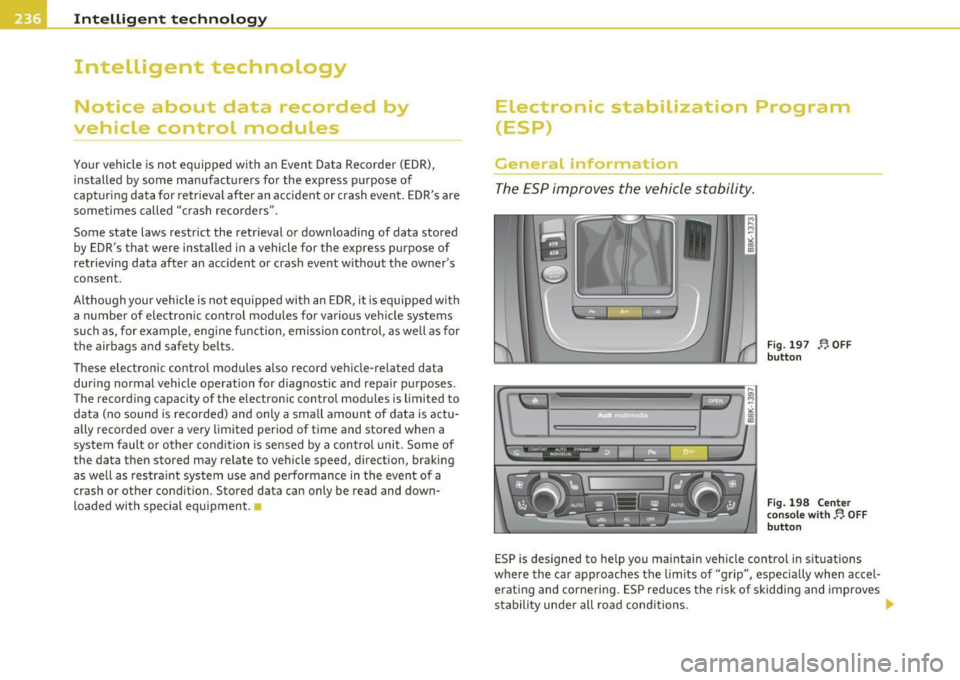
Intelligent technology
~----------------------------------------------
Intelligent technology
Notice about data recorded by
vehicle control modu Les
Your vehicle is not equipped with an Event Data Recorder (EDR),
installed by some manufacturers for the express purpose of
capturing data for retrieval after an accident or crash event. EDR's are
sometimes called "crash recorders".
Some state laws restrict the retrieval or downloading of data stored
by ED R's that were installed in a vehicle for the express purpose of
retrieving data after an accident or crash event without the owner's
consent.
Although your vehicle is not equipped with an EDR, it is equipped with
a number of e lectronic control modules for various vehicle systems
such as, for example, eng ine function, emission control, as well as for
the airbags and safety belts.
These electronic control modules also record vehicle-related data
during normal vehicle operation for diagnostic and repair purposes .
The recording capacity of the electronic control modu les is limited to
data (no sound is recorded) and only a sma ll amount of data is actu
ally recorded over a very limited period of time and stored when a
system fault or other condition is sensed by a control unit. Some of
the data then stored may relate to vehicle speed, direction, braking
as well as restraint system use and performance in the event of a
crash or other condition. Stored data can only be read and down
loaded with special equipment .•
Electronic stabilization Program
(ESP}
Ce-ieral lnforrrc:t~on
The ESP improves the vehicle stability.
Fig. 197 ;';. OFF
button
Fig. 198 Center
console with;';.
OFF
button
ESP is designed to he lp you maintain vehicle control in situations
where the car approaches the limits of "grip", especially when accel
erat ing and cornering. ESP reduces the risk of skidding and improves
stability under all road conditions.